Inside the Deal: Lexipol LLC
Firm,Investment Banking
Founded in 2003, Lexipol provides policy management, training and wellness software for public safety organizations and local government customers. Baird was recently lead advisor to Lexipol on its sale to GTCR.
Chase Sanders and Jeremy Fiser of Baird’s Software team talk about what made Lexipol an intriguing business model and the trends in the public safety and government software space.
What’s attracting investors to the public safety and government software space?
Fiser: First and foremost, it starts with the critical need of these solutions and the role the play in enabling compliance and mitigating risk. The first responder market is undergoing dramatic changes following social unrest and other high-profile events in the U.S. In Lexipol’s case, there’s a strong spotlight on public safety agencies, which in turn has increased the importance of having robust policies, training and wellness solutions. For these public safety agencies, there is a sense of urgency to better serve and keep their communities safe through the adoption of solutions that will enable them to manage risk and compliance and better support agency members working in high-stress environments. These themes all speak to the non-discretionary nature of these public safety solutions, which is viewed favorably by investors.
Across the board, government organizations are recognizing the value of investing in software tools to support their daily mission. State and local agencies have generally lagged in the broader shift to digital-based solutions – a phenomena that got exposed during COVID. They’re in the process of catching up – and COVID helped accelerate that transition – creating a long-term tailwind to this market that is attractive to investors.
What’s unique about Lexipol, and what made the company appealing to investors?
Sanders: Lexipol is the only SaaS-based policy, learning and wellness platform. The solutions are very comprehensive, including a continuously updated digital policy manual content, an extensive digital training course library and a full suite of wellness resources. It can truly function as an operational hub for its clients.
More than 7,200 agencies in all 50 states use Lexipol, including law enforcement, fire, EMS, corrections and local government. We believe Lexipol is uniquely positioned to address the current environment for first responders through its comprehensive solution offering.
One particularly unique aspect of Lexipol’s platform, that is incredibly timely based on the current state of the first responder market, is the Company’s wellness solutions. First responders are on the front lines of traumatic events, which can take an enormous emotional and mental health toll. The Lexipol platform includes a full suite of tools, resources and assessments for first responders. They’re available 24/7/365 on mobile devices and completely confidential – which allows first responders to seek and receive support, without stigma. This wellness solution reinforces the Company’s policy and training solution to enable the highest degree of efficacy and execution of the daily mission.
Further, Lexipol has a proven organic and inorganic growth profile and strong business metrics. The Company has a best-in-class mix of growth and profitability with substantial white space in front of it to continuing driving outsized growth well into the future.
Turning to the future, what should potential buyers know about this space?
Fiser: The market is large, and the tailwinds are strong – particularly the tailwinds related to compliance and risk mitigation as well as overall digital adoption in the government market. This is all creating a large white-space opportunity that will continue well into the future. With Lexipol for example, we don’t see the increased focus on first responders' accountability abating anytime soon, and the cost of non-compliance and potential “headline risk” will remain steep.
At the same time, vendor rationalization is very much in progress. Agencies are looking at their vendor base with an eye toward minimizing costs, complexity and ultimately the number of providers they work with – a trend that will favor larger scaled providers. We believe that this dynamic will continue to drive a consolidation across the largely fragmented government software market.
The need to enhance capabilities and increase solution offerings is driving market consolidation, as larger players turn to M&A to procure new or complementary capabilities for their existing platform. Providers with a niche solution offering in a geography of interest are highly sought-after targets for acquirors. We expect M&A activity in this market to remain robust for the foreseeable future.
Additionally, the funding environment is very favorable. State and local budgets fared better than expected through the pandemic and were bolstered with stimulus funds. This is benefiting purchase decision across the public safety sector and creating long-term adoption of solutions.
For additional information about this transaction, please contact:






